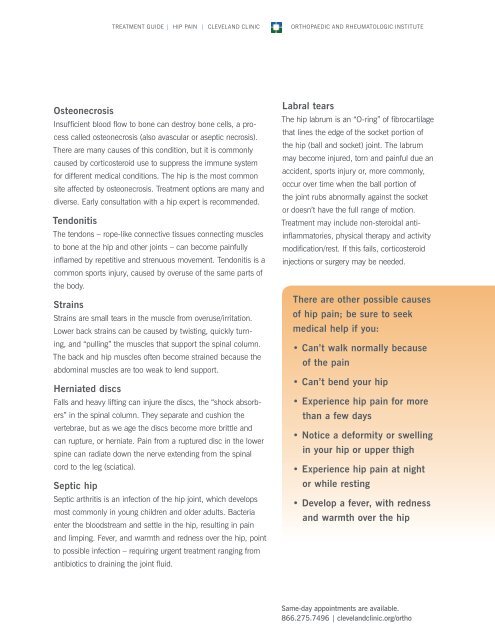Treatment Guide Hip Pain - Cleveland Clinic
Treatment Guide Hip Pain - Cleveland Clinic
Treatment Guide Hip Pain - Cleveland Clinic
Create successful ePaper yourself
Turn your PDF publications into a flip-book with our unique Google optimized e-Paper software.
Osteonecrosis<br />
TREATMENT GUIDE | HIP PAIN | CLEVELAND CLINIC<br />
Insufficient blood flow to bone can destroy bone cells, a pro-<br />
cess called osteonecrosis (also avascular or aseptic necrosis).<br />
There are many causes of this condition, but it is commonly<br />
caused by corticosteroid use to suppress the immune system<br />
for different medical conditions. The hip is the most common<br />
site affected by osteonecrosis. <strong>Treatment</strong> options are many and<br />
diverse. Early consultation with a hip expert is recommended.<br />
Tendonitis<br />
The tendons – rope-like connective tissues connecting muscles<br />
to bone at the hip and other joints – can become painfully<br />
inflamed by repetitive and strenuous movement. Tendonitis is a<br />
common sports injury, caused by overuse of the same parts of<br />
the body.<br />
Strains<br />
Strains are small tears in the muscle from overuse/irritation.<br />
Lower back strains can be caused by twisting, quickly turn-<br />
ing, and “pulling” the muscles that support the spinal column.<br />
The back and hip muscles often become strained because the<br />
abdominal muscles are too weak to lend support.<br />
Herniated discs<br />
Falls and heavy lifting can injure the discs, the “shock absorb-<br />
ers” in the spinal column. They separate and cushion the<br />
vertebrae, but as we age the discs become more brittle and<br />
can rupture, or herniate. <strong>Pain</strong> from a ruptured disc in the lower<br />
spine can radiate down the nerve extending from the spinal<br />
cord to the leg (sciatica).<br />
Septic hip<br />
Septic arthritis is an infection of the hip joint, which develops<br />
most commonly in young children and older adults. Bacteria<br />
enter the bloodstream and settle in the hip, resulting in pain<br />
and limping. Fever, and warmth and redness over the hip, point<br />
to possible infection – requiring urgent treatment ranging from<br />
antibiotics to draining the joint fluid.<br />
ORTHOPAEDIC AND RHEUMATOLOGIC INSTITUTE<br />
Labral tears<br />
The hip labrum is an “O-ring” of fibrocartilage<br />
that lines the edge of the socket portion of<br />
the hip (ball and socket) joint. The labrum<br />
may become injured, torn and painful due an<br />
accident, sports injury or, more commonly,<br />
occur over time when the ball portion of<br />
the joint rubs abnormally against the socket<br />
or doesn’t have the full range of motion.<br />
<strong>Treatment</strong> may include non-steroidal anti-<br />
inflammatories, physical therapy and activity<br />
modification/rest. If this fails, corticosteroid<br />
injections or surgery may be needed.<br />
There are other possible causes<br />
of hip pain; be sure to seek<br />
medical help if you:<br />
• Can’t walk normally because<br />
of the pain<br />
• Can’t bend your hip<br />
• Experience hip pain for more<br />
than a few days<br />
• Notice a deformity or swelling<br />
in your hip or upper thigh<br />
• Experience hip pain at night<br />
or while resting<br />
• Develop a fever, with redness<br />
and warmth over the hip<br />
Same-day appointments are available.<br />
866.275.7496 | clevelandclinic.org/ortho

















